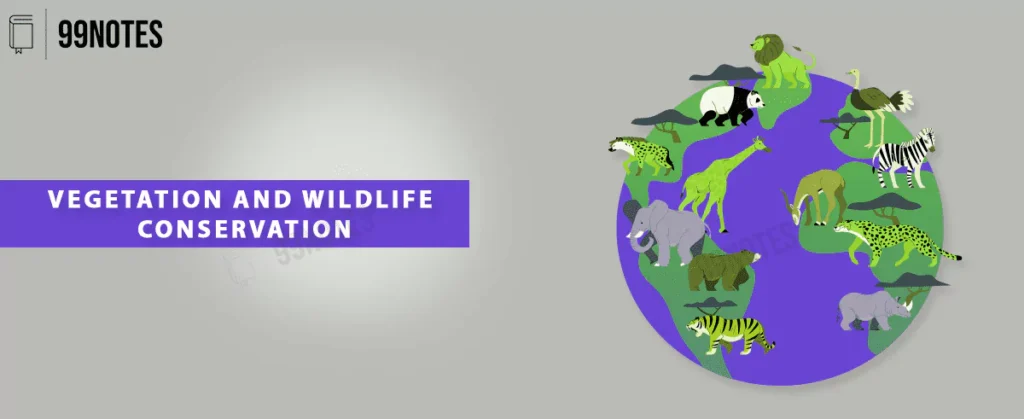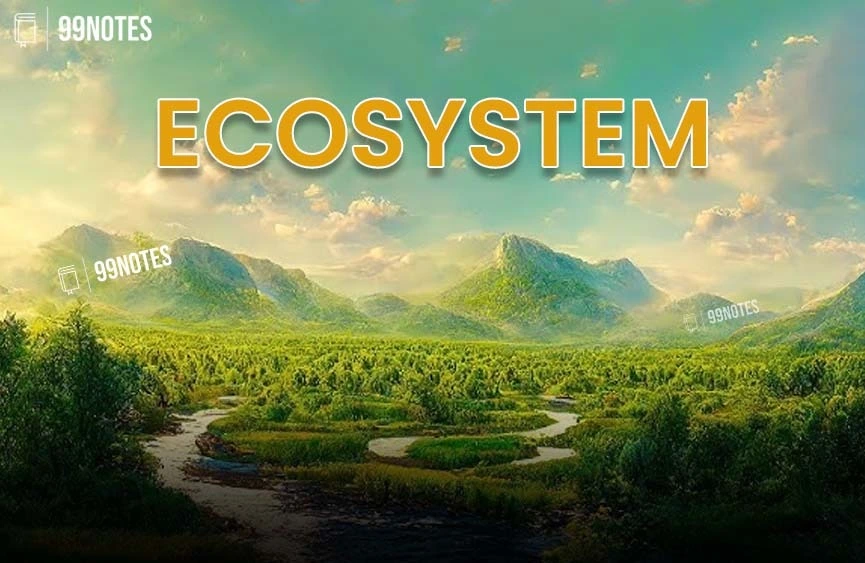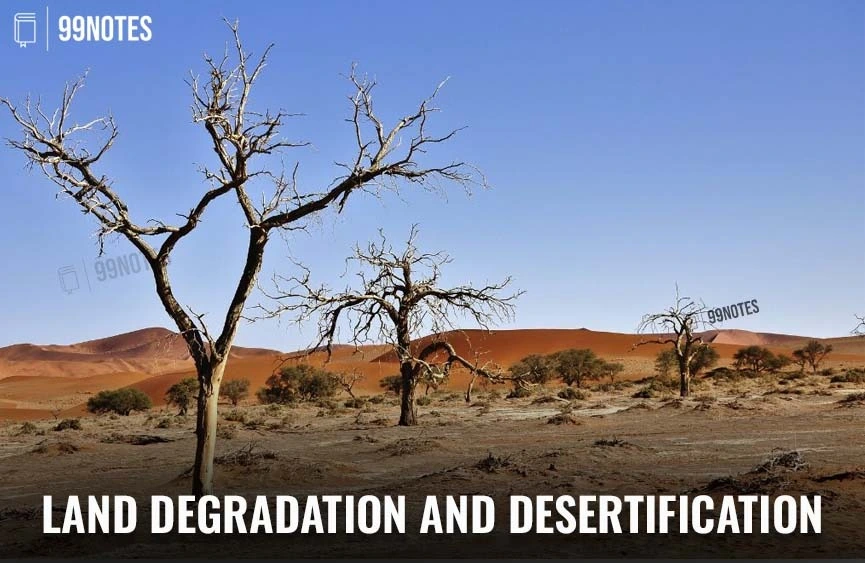
Vegetation & Wildlife Conservation Free UPSC Notes Download

Ecosystem
Ecology: Greek words ‘oikos’ meaning ‘house’, ‘logy’ meaning the ‘science of’. Literally, ecology is the study of the earth as a ‘household’, of plants, human beings, animals and micro-organisms. They all live together as interdependent components.

Biochemical Cycles
For last 1 billion years, atmosphere and hydrosphere have been composed of same balance of chemical components. The balance of chemical elements is maintained by a cyclic passage through the tissues of plants and animals.

Organisms and Populations
Ecology is a subject which studies the interactions among organisms and between the organism and its physical (abiotic) environment. Ecology is basically concerned with four levels of biological organisation

Biodiversity
The prefix ‘bio’ literally refers to something related to life and diversity refers to the variety. Biodiversity is the number and variety of organisms found within a specified geographic region This term popularised by the American socio-biologist

Forests of India
Forests are large ecosystems dominated by trees, plants, and wildlife. They cover about 31% of Earth’s land area.
They provide oxygen, store carbon, regulate climate, and support biodiversity.

Conservation Areas of India
A few Unique and representative ecosystems of terrestrial and coastal areas are internationally recognised within the framework of UNESCO’s Man and Biosphere (MAB) Programme.

Wildlife conservation in India
Normal Species: Population level considered normal for survival. For example, Cattle, sal, pine, rodents, etc. Endangered species: Danger of extinction. (due to negative factors)

Big Cats
Gujarat holds Asiatic lions exclusively, and their numbers have now risen to an estimated 674 in the Gir forest region and other revenue areas of coastal Saurashtra. Moreover, the distribution of the lions expanded from 22,000 sq.

Birds
Bonn Convention or Convention on Conservation of Migratory Species (CMS), 1979: an intergovernmental treaty, concluded under the aegis of the UNEP The only global and UN–based intergovernmental organization

Land Degradation and Desertification
Desertification is the process by which the biological productivity of drylands (arid and semiarid lands) is reduced due to natural or manmade factors. Land degradation: a process in which the value of the biophysical

Littoral & Swamp Forests
Areas of marsh, fen, peatland or water,
whether natural or artificial, permanent or temporary, with water that is static or flowing, Fresh, Brackish or salt water, including areas of marine water the depth of which at low tide does not exceed 6m
Vegetation & Wildlife Conservation
Vegetation and wildlife conservation refers to the protection and management of plant and animal species and their habitats.
It is important for maintaining biodiversity, which is the variety of different species in an ecosystem.
Biodiversity is vital for the health and functioning of ecosystems, as it helps to ensure that ecosystems can adapt to changing conditions and can provide a range of benefits to humans, such as food, medicine, and natural resources.
There are several ways in which vegetation and wildlife can be conserved, including:
- Protected areas: Protected areas are areas of land or water that are set aside for the protection of plant and animal species and their habitats. These can include national parks, wildlife sanctuaries, and nature reserves.
- Species conservation: Species conservation involves protecting and managing individual species that are at risk of extinction. This can include measures such as breeding programs and habitat restoration.
- Habitat conservation: Habitat conservation involves protecting and managing the natural environments in which plants and animals live. This can include measures such as land management practices, water conservation, and controlling pollution.
- Sustainable use: Sustainable use involves the use of natural resources in a way that does not harm the environment or deplete the resource. For example, sustainable forestry involves the careful management of forests to ensure that they are not over-exploited.
- Education and awareness: Raising awareness about the importance of vegetation and wildlife conservation can help to encourage people to take action to protect the environment. This can include educational programs, campaigns, and events.
Wildlife of India
India has an abundance of both vegetation and animals. India is home to around 90,000 animal species and roughly 2,000 bird species, representing 13% of the world’s total. India is home to 2,546 fish species, which accounts for almost 12 percent of the global supply.
In Kerala, Karnataka, and Assam, hot, humid jungles are home to the elephant, the most regal of animals. The one-horned rhinoceros is native to the wetlands of Assam and West Bengal. The Thar desert and Rann of Kachchh are noted for their separate populations of camels and wild asses. India is also home to Nilgai (blue bull), Indian bison, chousingha (four-horned antelope), gazelle, and several kinds of deer and monkeys. The Indian lion’s native home is the Gir forest in Gujarat. India is the only nation on earth with both lions and tigers.
Ladakh is home to the approximately one-ton shaggy-horned wild bull, the yak, the bharal (blue sheep), and the Tibetan wild ass (kiang). The ibex, the bear, the snow leopard, and the extremely uncommon red panda are also present in small areas of the Himalayas.
Turtles, gharials, and crocodiles inhabit India’s rivers, lakes, and coastlines.
India is also home to a variety of colourful birds, including peacocks, ducks, parakeets, cranes, and pigeons.
In 1972, the Wildlife Protection Act was enacted to establish a legislative framework for the conservation and protection of India’s wildlife.
There are 103 national parks and 535 wildlife preserves in India.
The Indian government, in partnership with UNESCO’s “Man and Biosphere Programme,” has taken special steps to preserve the country’s flora and wildlife.
In 1973, Project Tiger was initiated to conserve Tigers in India. It was the first effort of its sort to preserve the tiger population in India and protect them from poaching and other dangers. Initially established in nine tiger reserves, Project Tiger was eventually expanded to 44 tiger reserves (in 17 states).
Initiated in 1992, Project Elephant seeks to secure the long-term survival of elephant populations in their native habitats by safeguarding elephants, their habitats, and migration routes. In 17 states, the initiative is being executed.
The Government of India has also created Project Hangul, the Crocodile Breeding Project, and the Himalayan Musk deer Conservation Project.
Vegetation and wildlife conservation is important for maintaining the health and balance of ecosystems, and it also has economic and social benefits. For example, protected areas can attract tourists, and the use of sustainable resources can provide a source of income for local communities.
Other Topics Related to Environment:
| Environment Pollution | Disaster Management |
| Environment Impact Assessment | Agriculture |
| Current Affairs | UPSC GS 3 Syllabus & Notes |

